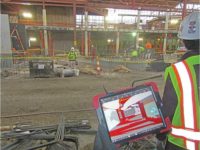A long time ago in a galaxy far, far away... the goal of a digital twin was clear. From a stolen digital representation, Princess Leia and her rebel commanders could pinpoint the Imperial Death Star’s fatal flaw – and send in their X-Wing Fighters and Jedi to destroy it.
Back in the real world, digital twins are less about destroying intergalactic space stations, and more about optimizing the life and operations of hugely complex and expensive assets across the industrial sectors. Less cinematic certainly, but infinitely more attractive.
The premise is the same: a digital replica that provides complete visualization of an asset, relying on data technology to deliver previously unavailable and remote insight into almost every aspect of its design, operation and performance. The digital twin capacity can be retrofitted to a broad range of assets to improve performance and productivity – from immersive technology in design, to informing the supply chain in operations.
The concept of a digital twin is a mature one, and its ability to deliver real value is already proven in the manufacturing sector, for example. So why are digital twins yet to deliver on their promise in key areas like energy or the built environment?
As Built vs. As Maintained
Although design, construction and operations specialists have proven to be proficient in creating 3D images of even the most complex, multibillion-dollar assets, that is usually where the application of digitization has stopped.
Oil rigs and wind turbines to petrochemical plants and pharmaceutical environments, even cities, have all been digitally rendered, and that process has driven significant efficiencies into the planning and construction processes. Crucially, digital twins are almost always ‘as built’. Once the asset is handed over to operations, there is very little information on how to run and maintain it at an optimal level, especially in real-time.
In other words, the ‘as maintained’ picture is still largely absent. Once fatigue and degradation take their toll, digital twins no longer match their physical counterparts.
That’s not to say that work has not been done in this area. There are pockets of brilliance around the world that are often buried in projects, that can bring more effective data analysis into the mix.
One part of the solution therefore is to extend “digital twin” thinking out from the design-and-build stage and into operations and maintenance. The next challenge then is to decide who is best placed to deliver the capability needed to create successful solutions for the real world.
Orchestrated Technologies
They may lack the sci-fi gloss of the Star Wars special effects department, but at a technical level real-world digital twins can be significantly more sophisticated. For example, as a user ‘walks’ through a remote asset, layers of information can be added to provide real-time or near-real time status updates. Potential issues can be highlighted as red, amber or green and classified. Filters allow users to view specific details – floor plans, maintenance schedules, previous works, equipment serial numbers, costs, schedules, outputs – and make decisions without ever setting foot on the asset.
Internet of Things technology (sensors, connectivity, analytics and cyber-security) create an automatic feedback loop so the asset itself can provide updates on its own status to keep it in-sync with its twin. Multiple systems, new and old, are orchestrated, managed, and brought together to create value.
There isn’t a single provider that can deliver all of that. So, in addition to orchestrating individual technologies, operators must orchestrate multi-faceted teams of vendors and experts.
A New Hope
The capability is there – so is the expertise. The answer lies in bringing them together effectively. That means adopting more of an ecosystem approach to digital twins and working with partners who can integrate not just the various systems, but the underlying design, build and operational expertise that informs development.
As a systems integrator (SI), Wood has put in the hard yards with the hard hats, which means that the team understands the physical reality as much as its digital adjunct. This kind of ‘industry-first’ expertise is essential to bringing together all the components and skills needed in both the energy sector and the built environment.
The industry-first approach can make fully informed contributions to the design and construction of the proposed asset, or even take on the build in its entirety. Equally, it can determine which assets would benefit from retrofitting so that investment can be directed where it delivers most value. Crucially, operators like Wood can contextualize and mediate some of the wilder claims made by technology providers as to their ability to deliver.
This is particularly important where complex assets are concerned. In the five years between investment decisions and asset go-live, technology will advance significantly. The SI must be able to help asset operators and building owners navigate that time lag, and so a ‘future-ready now’ mindset is a key success factor.
Finally, there is the all-important CAPEX vs OPEX question. Renewed capital constraints have placed the issue front and centre, but a successful digital twin strategy is based more on a TOTEX – total expenditure – approach. Digital twins can reduce OPEX by a significant amount, with direct consequences for profitability. But getting the necessary tech specs to deliver on those requirements will almost certainly rebalance the CAPEX and OPEX calculation. Again, this is something that the right SI will be able to support.
The problem with digital twins to date has not been one of technology. It has been one of approach: of technology first rather than industry first. Above all, successful digital twins are about a successfully led ecosystem; no single company can do all this alone. Instead, strength comes from networks and a real alliance. That is how science fiction becomes a digital reality.
Darren Martin is chief technology officer of Wood, a global leader in engineering and consultancy across energy and the built environment, helping to unlock solutions to some of the world’s most critical challenges.





Post a comment to this article
Report Abusive Comment